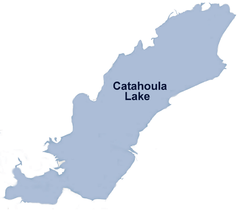Catahoula Lake
Catahoula Lake is a large freshwater lake located in La Salle Parish and Rapides Parish of central Louisiana, United States.
| Catahoula Lake | |
|---|---|
 | |
| Location | La Salle / Rapides parishes, Louisiana, United States |
| Coordinates | 31°30′45″N 092°06′26″W |
| Basin countries | United States |
| Surface area | 30,000 acres (12,000 ha) |
| Designated | 18 June 1991 |
| Reference no. | 523[1] |
Catahoula Lake is the largest natural freshwater lake in the state covering just over 46 square miles (120 km2). It is owned by the State of Louisiana and managed by the U.S. Army Corps of Engineers, the U.S. Fish and Wildlife Service, and the Louisiana Department of Wildlife and Fisheries.
Catahoula is a shallow, and poorly drained wetland supported by the Little River and several creeks. It was drained by the Old River, French Fork and a number of bayous until several flood control projects changed the lake's drainage characteristics.
It is known as the largest moist soil unit in North America and supports a variety of waterfowl including geese, duck, and wading birds and is a recreational area for hunting, fishing, hiking, sight seeing, and bird watching. Access to the lake is limited on the western shores due to private and corporate fencing.
Controversy
There has been controversy over the classification of Catahoula Lake. The area is considered a "salt lake" that was created when seismic activity caused the land to sink. The area has dry and wet period cycles flooding annually from the Little, Red, Ouachita (Black) River, and Mississippi River. To advance the wildlife ecosystem, including ducks, control structures were built to enhance this annual flooding. Every year after June most of the water is drained facilitating flora growth especially Chufa that is also called yellow nutsedge.[2] A lawsuit and district court ruling determined that the area is not a lake but a river. The ramifications of this ruling, that has been appealed to The Third Circuit Court of Appeals, is that as a river it may not be managed for public use.[3]
References
- "Catahoula Lake". Ramsar Sites Information Service. Retrieved 25 April 2018.
- Louisiana Sportsman- Retrieved 2018-05-14
- NOLA Media (The Times-Picayune- posted Aug 10, 2017)- Retrieved 2018-05-14